Research in Fiscal Year 1998
Research in Fiscal Year 1998 Findings of Active Fault Survey Projects
Cover |
Back cover |
The followings are main results of active fault and paleoearthquake researches in the 1998 fiscal year. They are published in the Geological Survey of Japan Interim Report no. EQ/99/3 (Interim Report on Active Fault and Paleoearthquake Researches in the 1998 Fiscal Year).Map of the Studied Area
Summarized survey result and earthquake potential of major active faults in the Kinki Triangle, central Japan [PDF 24KB]
Authors: Yuichi Sugiyama, Koichi Shimokawa, Yasuo Awata, Kenji Satake, Kiyohide Mizuno, Toshikazu Yoshioka, Taku Komatsubara, Futoshi Nanayama, Yoshihiko Kariya, Takashi Azuma, Yuichiro Fusejima, Eikichi Tsukuda, Akira Sangawa and Toshihiko Sugai (Univ. Tokyo)
Abstract:
After the 1995 Kobe earthquake, the Geological Survey of Japan is conducting systematic study of major active faults in the Kinki Triangle, a central part of Japan containing Osaka and Nagoya metropolitan areas. We have studied 25 active faults, about 75% faults in this region, by the end of the 1998 fiscal year. We rearranged these faults into 18 seismogenic faults based on the criteria proposed by Matsuda (1990) for grouping and dividing faults. We next divided the seismogenic faults into 31 behavioral segments, using 2-km distance, difference in rupture history, and a value of 20,000×displacement per event as criteria for segmentation.
Earthquake potential of each segment was assessed based on the elapsed time ratio and probability for rupture in the coming 100 years. It is made clear that the 24-km-long Aibano segment with 3 to 5 m unit slip, on the west coast of Lake Biwa, has 12 to 38% probability of an M≧7 earthquake within the next 100 years. The 44-km-long Uemachi fault traversing Osaka has 5% probability of a big earthquake in the coming 100 years at the maximum.
On the other hand, at least 14 behavioral segments including the Hokudan which produced the Kobe earthquake have relatively low earthquake potential. Their probabilities for rerupturing in the next century are less than 0.2%. Most of them proved to be causative faults of disastrous historical earthquakes such as the 1325 Shochu, 1586 Tensho, 1596 Keicho and 1662 Kanbun earthquakes.
Seismogenic faults and behavioral segments in the Kinki Triangle and their elapsed time ratios.
Seismogenic faults and behavioral segments in the Kinki Triangle and their probability for an earthquake in the next 100 yr.
Geological Survey of Japan, AIST
- About GSJ
- Our Activities
- Purchase guide
-
Publications and Database
- information
- Bulletin of the Geological Survey of Japan
- bull2025(Vol.76)
- bull2024(Vol.75)
- bull2023(Vol.74)
- bull2022(Vol.73)
- bull2021(Vol.72)
- bull2020(Vol.71)
- bull2019(Vol.70)
- bull2018(Vol.69)
- bull2017(Vol.68)
- bull2016(Vol.67)
- bull2015(Vol.66)
- bull2014(Vol.65)
- bull2013(Vol.64)
- bull2012(Vol.63)
- bull2011(Vol.62)
- bull2010(Vol.61)
- bull2009(Vol.60)
- bull2008(Vol.59)
- bull2007(Vol.58)
- bull2006(Vol.57)
- bull2005(Vol.56)
- bull2004(Vol.55)
- bull2003(Vol.54)
- bull2002(Vol.53)
- bull2001(Vol.52)
- Bulletin of the Geological Survey of Japan(old)
- Annual Report on Active Fault and Paleoearthquake Researches
- Reports, Geological Survey of Japan
- CCOP-GSJ Groundwater Project Report
- CCOP Technical Bulletin
- Cruise Report
- Geological Hazards
- Learning and Education
- GSJ Database Collection
- Collection of links

